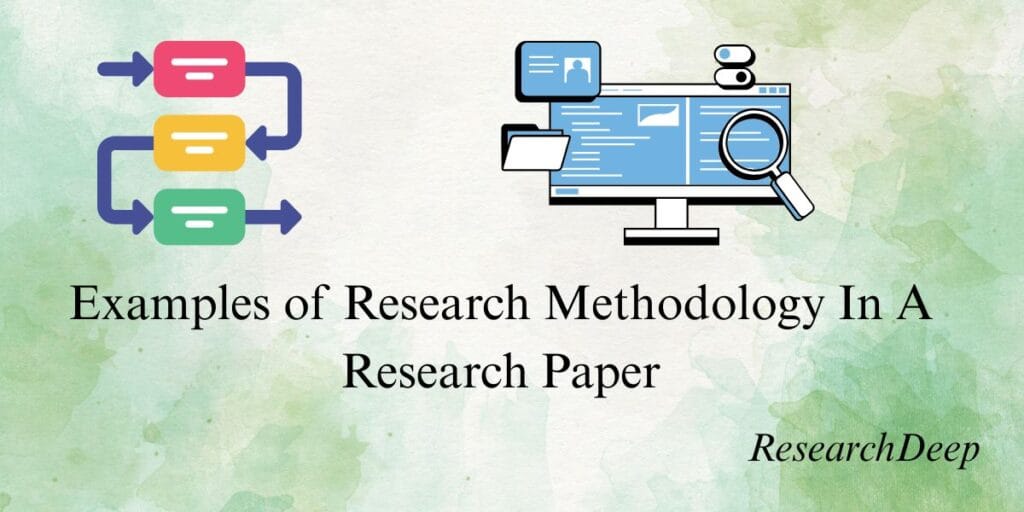Introduction
The research methodology of a research paper section describes how the study was designed, conducted, and analyzed. It explains the logic behind each step — from sampling to data analysis — so readers can evaluate the validity and reliability of the results.
This section not only guides readers through the research process but also ensures replicability, a cornerstone of academic integrity. The structure of your methodology varies depending on the research design, whether the study is quantitative, qualitative, or mixed-method.
Below are two complete examples of research methodology in a research paper— one quantitative and one qualitative — showing how to write a strong research methodology section for your research paper.
Table of Contents
Types of Research Methodologies
Quantitative Research
Uses numerical data, surveys, and experiments to test hypotheses. Focuses on statistical accuracy and measurable relationships.
Qualitative Research
Explores experiences, meanings, and perceptions using interviews, focus groups, and thematic analysis.
Mixed-Methods Research
Combines quantitative and qualitative techniques for both depth and generalizability in understanding a research problem.
Example 1: Quantitative Methodology (Survey-Based Study)
1. Research Design
This study adopted a quantitative, cross-sectional survey design to examine undergraduate students’ perceptions of their university’s dress code. A descriptive approach was chosen to provide a detailed overview of student attitudes during the Fall 2025 semester.
Rationale:
Quantitative research enables the measurement of opinions and attitudes across large populations, offering statistical evidence that can be generalized.
(Creswell & Creswell, 2018)
2. Participants
The target population consisted of undergraduate students enrolled at a large state university. A total of 250 participants were recruited through campus-wide email invitations and flyers displayed in high-traffic areas such as libraries and student unions.
A quota sampling method ensured equal representation from each academic year: first-year students, sophomores, juniors, and seniors. This approach improved sample diversity and minimized bias from overrepresentation of any single cohort.
Example:
Of the 250 participants, 140 identified as female (56%), 108 as male (43%), and two as non-binary (1%).
(Etikan & Bala, 2017)
3. Data Collection
Data were collected via a self-administered online survey built in Google Forms.
- The survey contained 25 closed-ended questions, including 18 Likert-scale items (1 = Strongly Disagree to 5 = Strongly Agree).
- Demographic questions (age, gender, and major) were added to identify group differences.
- The survey link remained active for 2 weeks, and two reminder emails were sent to increase participation.
Example Question:
“The university’s dress code promotes a sense of professionalism among students.”
4. Data Analysis
The data collected were first exported from Google Forms into Microsoft Excel for cleaning (removal of incomplete responses). The dataset was then imported into SPSS Version 29 for statistical analysis.
- Descriptive statistics (means, standard deviations, and frequencies) summarized participant responses.
- Inferential tests, such as t-tests and Pearson correlations, assessed differences by gender and academic year.
- Reliability analysis (Cronbach’s α = 0.87) confirmed the scale’s internal consistency.
Example:
The results showed that senior students (M = 3.8, SD = 0.9) viewed the dress code more positively than first-year students (M = 3.1, SD = 1.1), t(248) = 3.22, p < .01.
(Field, 2018)
5. Ethical Considerations
Participants were shown an electronic consent form before accessing the survey. The form explained:
- Participation was voluntary.
- Responses were anonymous.
- Data would be used for research purposes only.
The study protocol received approval from the University Institutional Review Board (IRB #25-108). All responses were stored in encrypted files, and identifying information was not collected.
Summary
This quantitative methodology demonstrates how structured sampling, controlled variables, and standardized analysis ensure statistical validity and reliability in behavioral research.
Example 2: Qualitative Methodology (Interview-Based Study)
1. Research Design
This study adopted a qualitative phenomenological design to explore the experiences of employees who have been working remotely for over a year. The aim was to uncover the essence of remote work as perceived by professionals across industries.
Rationale:
A phenomenological approach allows researchers to interpret lived experiences and reveal underlying meanings beyond what can be measured numerically.
(Silverman, 2020)
2. Participants
Eight professionals were selected using purposive sampling, ensuring diversity in gender, age, and occupation. All participants had at least 12 months of continuous remote work experience. Recruitment occurred via LinkedIn and personal referrals.
Example:
Participants represented fields such as education, marketing, IT, and finance, providing multi-sector insights into work-from-home dynamics.
3. Data Collection
Data were collected through semi-structured Zoom interviews lasting 45–90 minutes each. Interviews were audio-recorded with consent and transcribed verbatim.
Sample interview questions included:
- “What does a typical workday look like for you?”
- “What challenges have you faced while working remotely?”
- “How has remote work affected your work-life balance?”
The open-ended format encouraged participants to narrate their experiences freely, promoting rich data collection.
4. Data Analysis
Thematic analysis (Braun & Clarke, 2006) was used to identify patterns within the transcribed data.
Steps included:
- Familiarization — Reading transcripts multiple times.
- Coding — Highlighting significant statements.
- Theme Generation — Grouping codes into meaningful clusters.
- Review and Refinement — Comparing themes with original data.
- Reporting — Selecting vivid, representative quotations.
Example:
Three core themes emerged: autonomy and flexibility, technological fatigue, and blurring of work-life boundaries.
5. Ethical Considerations
Informed consent was obtained before interviews began. Participants were reminded they could withdraw at any point without consequence.
Recordings and transcripts were stored on a password-protected drive, and pseudonyms replaced real names in the report.
Summary
This qualitative methodology illustrates how interviews, coding, and thematic analysis help reveal deep insights into human experiences — ideal for studies emphasizing context and perception.
Choosing Between Quantitative and Qualitative Methodologies
Selecting the correct methodology is one of the most critical decisions in any research paper. Your choice depends on your research objectives, the nature of your data, and the research questions you aim to answer.
Quantitative methods are ideal when you seek measurable, generalizable findings, whereas qualitative methods uncover deeper meanings and contextual insights.
The following table highlights the key quantitative and qualitative research differences to help you determine which approach best aligns with your research design.
| Criteria | Quantitative Methodology | Qualitative Methodology |
|---|---|---|
| Primary Focus | Measures variables numerically and tests hypotheses using statistical analysis. | Explores meanings, perceptions, and lived experiences through non-numerical data. |
| Research Design | Structured, predetermined (e.g., experimental, correlational, survey). | Flexible, evolving (e.g., phenomenological, case study, ethnographic). |
| Data Collection | Surveys, questionnaires, standardized tests, experiments. | Interviews, focus groups, participant observation, document review. |
| Data Type | Numeric (quantifiable and measurable). | Textual, visual, or narrative (rich descriptive data). |
| Analysis Technique | Statistical analysis (e.g., t-tests, ANOVA, regression). | Thematic, content, or discourse analysis using coding frameworks. |
| Outcome | Generates measurable, generalizable results and identifies trends. | Provides deep contextual understanding of complex social or personal phenomena. |
| Sample Size | Large; aims for representativeness and statistical significance. | Small; focuses on information-rich cases rather than representativeness. |
| Example | A survey of 300 students measuring the impact of online learning on GPA. | Interviews with 10 teachers exploring challenges in online teaching. |
Frequently Asked Questions
What is an example of a good research methodology?
A good methodology clearly describes the research design, data collection tools, analysis process, and ethical measures—with enough detail for replication.
What is the difference between qualitative and quantitative methodology?
Quantitative methods measure variables numerically and rely on statistics, while qualitative methods explore experiences through language, meaning, and interpretation.
How long should a research methodology be in a paper?
In a research paper, the methodology section typically ranges from 500 to 1,000 words, depending on the study’s complexity and the journal’s requirements.
Conclusion- Examples of Research Methodology In A Research Paper
A transparent, well-documented methodology is the single most crucial element that converts an interesting research idea into a credible scholarly contribution. The two worked examples in this article — a quantitative, survey-based methodology and a qualitative, interview-based phenomenological methodology — illustrate how method choices must flow directly from the research question, not the other way around. The quantitative example showed how structured sampling, standardized instruments, and statistical tests produce measurable, generalizable findings; the qualitative example demonstrated how purposive sampling, in-depth interviews, and thematic analysis uncover meanings, contexts, and nuance (Creswell & Creswell, 2018; Braun & Clarke, 2006).
For authors preparing methodology sections, prioritize the reader’s ability to judge and replicate your work. Use subheadings (Design; Participants; Data Collection; Analysis; Ethics; Limitations), include concrete examples (sample items, interview prompts, analytic code, or a codebook), and state software, thresholds, and decision rules explicitly. When reporting quantitative results, include reliability statistics (e.g., Cronbach’s α) and effect sizes alongside p-values; when reporting qualitative findings, include verbatim quotations to support theme interpretation and show how codes map to themes (Braun & Clarke, 2006; Field, 2018).
Finally, think of the methodology as an argument rather than a recipe. You are asking readers to accept that your approach was the best available way to answer your question, given the constraints. Justify your choices with references to established methodological literature, show you followed ethical best practice, and provide enough procedural detail to make replication feasible. Doing so not only improves the immediate credibility of a single paper but also contributes to the cumulative reliability of scholarship in your field.
Quick checklist before you finalize your methodology:
- Have you restated the research question and linked each method to it?
- Is your sampling strategy justified and described in detail?
- Are instruments, pilot testing, and data-cleaning steps documented?
- Have you reported analysis procedures, software, and decision rules?
- Did you describe ethical approvals, consent, and data protection measures?
- Have you candidly acknowledged limitations and mitigation steps?
When these elements are present and well-argued, your methodology becomes more than a section of the paper — it becomes evidence that your conclusions rest on sound, transparent, and ethically conducted research.
🧩 Key Takeaway
Quantitative methodologies use numbers and statistics for measurable results, while qualitative methodologies uncover experiences and meanings. Choose your method based on the nature of your research question.
- Clearly describe design, sampling, and analysis methods.
- Include ethical procedures and rationale for each choice.
- Ensure replicability through detailed documentation.
References
- Braun, V., & Clarke, V. (2006). Using thematic analysis in psychology. Qualitative Research in Psychology, 3(2), 77–101. https://doi.org/10.1191/1478088706qp063oa
- Creswell, J. W., & Creswell, J. D. (2018). Research Design: Qualitative, Quantitative, and Mixed Methods Approaches (5th ed.). Sage Publications.
- Etikan, I., & Bala, K. (2017). Sampling and sampling methods. Biometrics & Biostatistics International Journal, 5(6), 215–217. https://doi.org/10.15406/bbij.2017.05.00149
- Field, A. (2018). Discovering Statistics Using IBM SPSS Statistics (5th ed.). Sage Publications.
- Silverman, D. (2020). Doing Qualitative Research (6th ed.). Sage Publications.



